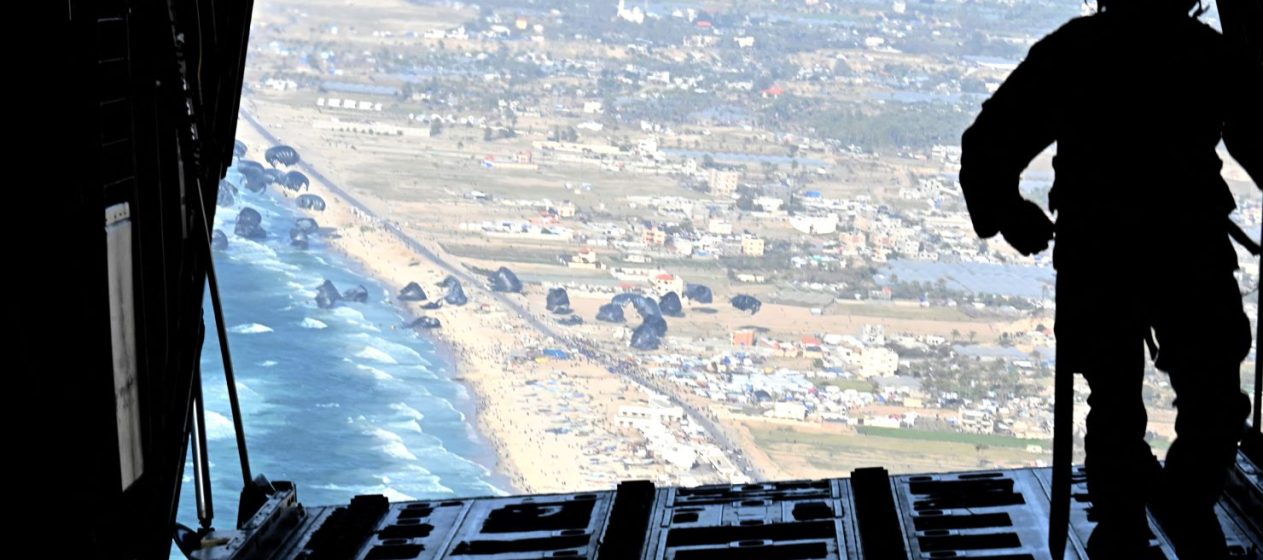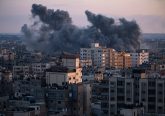Since October 7, Israel has blocked most food, water, hygiene items, and medicine from entering Gaza. The government has denied access to aid agencies, security inspections have deliberately slowed the entry of trucks, communication blackouts have cut off internet and phone services to more than two million residents, and Israeli protesters have lined up to block humanitarian aid supplies. Moreover, the US, UK, and other donors suspended funding to UNRWA, the UN’s aid agency for Palestine, after Israel accused staff members of participating in the October 7 attacks and called for the organisation to be disbanded. Crucially, these accusations have not been proven.
As a result, people in Gaza are starving. Sixteen children, and counting, have died of malnutrition, UN officials have warned that famine is imminent, and the World Food Programme has stated that one-sixth of all children under the age of two are acutely malnourished. After Israeli forces opened fire on a crowd of civilians trying to get aid on February 29 and killed over 100 people, the US announced that it would begin airdropping aid into Gaza.
Yet, the US operation has blatantly ignored the fact that the reason aid cannot get into Gaza is because Israel, supported by unconditional arms and funding from the US, is preventing it from entering in the first place. Parachuting inadequate amounts of aid to a civilian population fleeing American-made bombs is dehumanising, degrading, and woefully insufficient, allowing the Biden Administration to score political points all the while innocent civilians in Gaza continue to suffer.
Chaos by Design
Airdropping aid is one of the most ineffective methods of delivering humanitarian assistance to a besieged population. It fails to address the delivery issue on the ground, a key part of any aid process which needs to be managed. Jeremy Konyndyk, the president of Refugees International, noted that the organisation only uses airdrops when there is no other option available because the drops are disorganised and only deliver minimal amounts of food. It is not possible to control where airdropped packages land. Palestinian journalists have reported that airdropped aid has been scattered in arbitrary and inaccessible places throughout Gaza, including on the roofs of random buildings, with some ending up on the Israeli side of the border. The US is not the first to use this method of delivery; when Jordan previously airdropped aid into Gaza, large amounts of aid ended up in the sea, forcing starving people to swim out and retrieve the few supplies they could find. In both the Jordanian and American airdrop operations, aid has been destroyed due to crash landings from parachutes and poor organisation. This method of delivering aid is not only chaos by design, it is fundamentally dehumanising.
The Dehumanisation of Recipients
Researchers have noted that humanitarian aid delivery is often degrading to recipient populations. As Barbara Harrell-Bond argues, power dynamics underpin humanitarianism: the people who give humanitarian aid decide who gets to receive it and by what means, while the people who receive aid are supposed to be grateful no matter what. Aid is seen as an act of voluntary kindness on the part of the donor — a donation rather than the fulfilment of an obligation – while the donor maintains control over every stage of the donation.
In the rush of the delivery of humanitarian aid, the crucial aspect of ‘how’ it is delivered is too often ignored. In a 2015 study, Oxford Professor Tom Scott-Smith observed the distribution of humanitarian aid in the Yusuf Batil camp of South Sudan, noting that recipients were each given a ready-made mix of nutrients. They were not allowed any choice or even the possibility to prepare the meals themselves from ingredients; the aid agency maintained strict control over the entire process. This program, he argued, is representative of much humanitarian food distribution around the world, in which recipients of aid are treated as purely biological beings who merely require certain nutrients to survive, ignoring their agency as human beings. But people deserve more than just the nutrients to keep them alive. They deserve to be treated with dignity.
Airdropping aid takes this systematic humanitarian dehumanisation to a whole other level. Not only are recipients denied any choice about the aid they receive, the US operation in Gaza is dropping aid from the sky into random places, not caring where it goes. People are forced to run and swim after the food and pick up whatever they can. In this situation, it is likely that the vulnerable will suffer the most. One photo captured by a reporter showed children trying to pick up spilled flour off the ground to eat. Video footage also shows Israeli soldiers shooting at people trying to retrieve aid supplies on more than one occasion. The ‘humanitarian’ operation treats Palestinians like animals in a zoo who must await the food dropped upon them from the sky. As Iranian refugee and writer Dina Nayeri puts it, ‘why do we ask the desperate to strip off their dignity as the price of help?’.
Furthermore, by deliberately choosing to deliver aid in the most chaotic way possible and by providing only 30,000 meals for a population of 2.3 million people, the US appears to be purposively inciting a situation in which people turn against each other. As one commentator for the Middle East Monitor noted, the West seeks to portray “the starving Palestinians in Gaza […] as hungry savages scrambling and fighting each other to get food […] That, of course, is the exact opposite of the reality.” In his work, ‘Savages, Victims and Saviours: the Metaphor of Human Rights’ Makaua Mutua emphasises that Western states construct non-Western nations as ‘barbaric’ and in-need of saving in order to justify their paternalistic control. The US seeks to portray the Palestinians as the vulnerable victims in need of a Western saviour, all the while ignoring the true – and preventable — cause of this ‘humanitarian crisis’.
Avoiding Responsibility
As a former USAID director for the West Bank commented, airdrops are merely symbolic. The US could use its leverage to force Israel to allow aid trucks in, but it is choosing to remain silent. Instead, it is airdropping aid so that the Biden Administration can score political points domestically by seeming to address the suffering of the people of Gaza without actually addressing the core issue: the continued Israeli bombardment of Gaza and the blocking of aid. Indeed, by framing the starvation in Gaza as a humanitarian crisis rather than the result of political decisions, the US obfuscates its own complicity in creating the crisis to begin with. In the short-term, sufficient aid is certainly necessary to avoid mass famine. However, humanitarianism can never be the long-term solution to a man-made crisis, and solely focusing on humanitarianism makes it abundantly clear that the US has no intention of addressing the root causes. As Sadako Ogata, the former head of the UN Refugee Agency, noted, “there are no humanitarian solutions to humanitarian crises”.
Conclusion
Parachuting small amounts of food into Gaza is both insulting and inadequate, acting to dehumanise and remove dignity from the recipients. Instead, the US should recognise its own complicity in the starvation of Gaza, pressure Israel to stop blocking aid, and stop providing the weapons that make Israel’s bombardment of Gaza possible. Until the US does that, no amount of airdropped aid will be sufficient to help civilians survive.
Note: This article reflects the views of the author and not the position of the DPIR or the University of Oxford.







